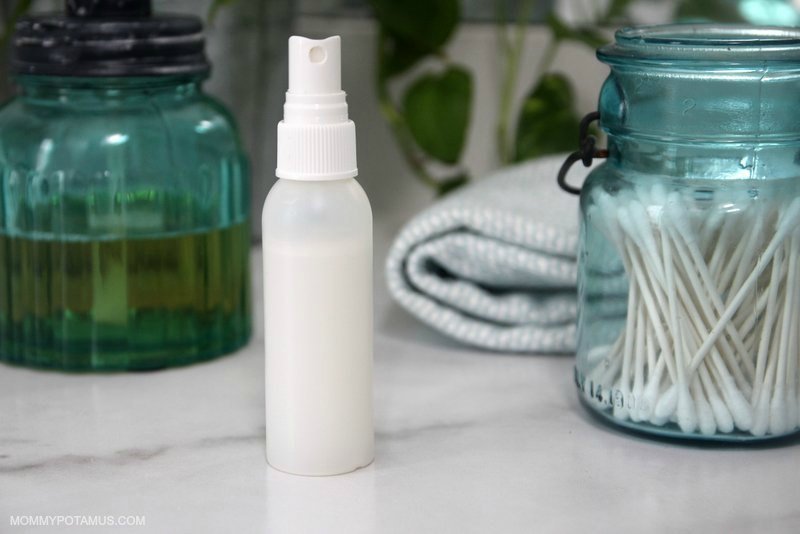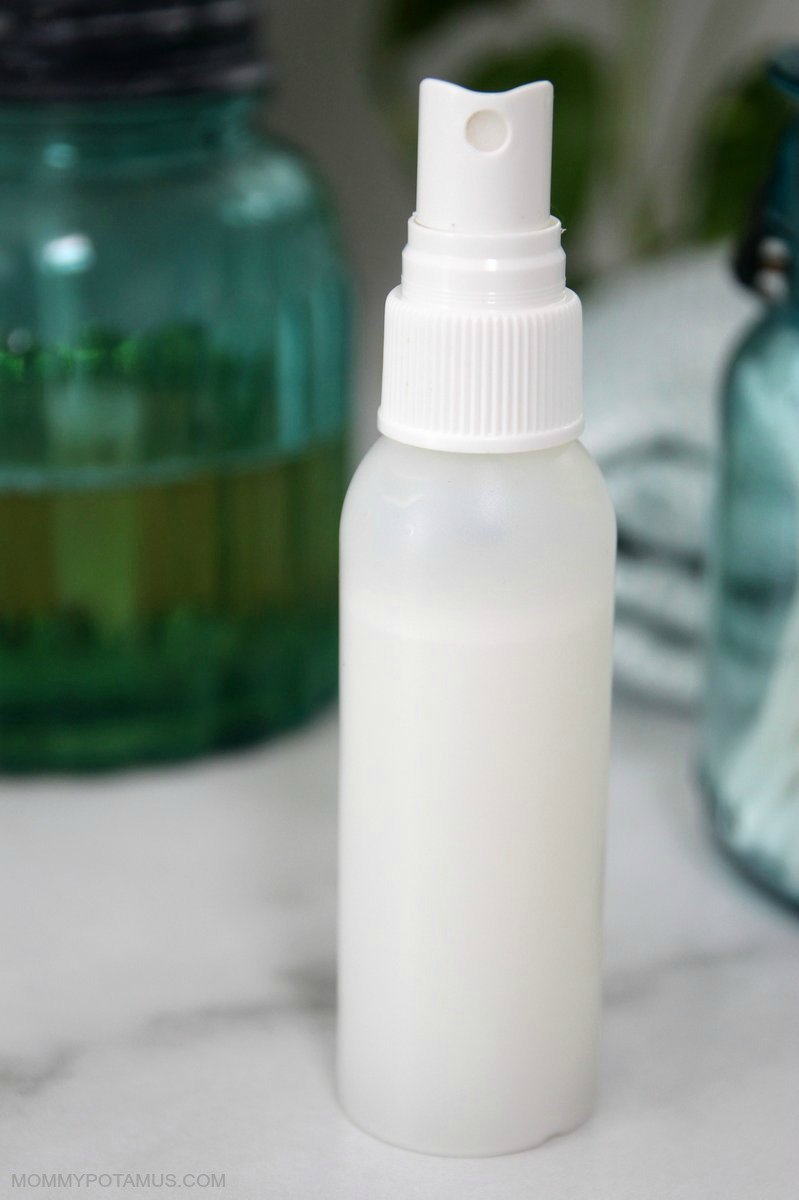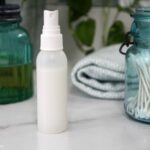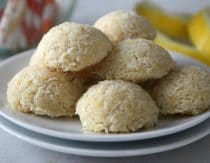
Coconut oil is the Swiss Army Knife of beauty products. It can be used to make this three-ingredient shampoo bar, homemade deodorant, lotion bars, and even tooth whitener. And, hey, you can just rub it on as a lovely body oil. But as a DIY leave-in conditioner? Yeah, not so much . . . it’s just too heavy for most people.
Fortunately, coconut milk softens and conditions without weighing hair down, and only takes minutes to make into a conditioner spray. When I first shared this recipe a few years ago it got a lot of rave reviews like this one:
Thanks for this amazingly simple recipe! I’ve used it on my thick, curly hair, as well as my young daughter’s fine, tangly hair, and it leaves our hair feeling soft and looking smooth. Hair brushing time is now almost tear free, what a huge relief!” – Rachael
I also got a fair amount of questions, so I’ve updated the post to answer the most common ones at the bottom of this post.
Also, if you’re looking for more easy hair care recipes, here are some of my other popular ones:
- DIY Dry Shampoo – These two easy recipes work for light or dark hair and take less than five minutes to make. You’ll only need two ingredients, and you probably already have them in your pantry.
- Natural Hair Gel – Many of the styling gels on store shelves contain hormone disrupting fragrances and formaldehyde releasers, but you can make natural hair gel with just 1-3 simple ingredients like aloe vera, essential oils, etc.
DIY Leave-In Conditioner Recipe
Equipment
- fork and whisk
- 2 oz spray bottle
- ice cube tray
Ingredients
- ¼ cup distilled water (or tap water that has been boiled for 5 minutes and allowed to cool)
- 1 tbsp full fat coconut milk ((or 2 tbsp homemade coconut milk, although canned tends to work better)
- 2 – 10 drops essential oil (optional)
Instructions
How To Make Leave In Conditioner Using Canned Coconut Milk
- Start by adding the essential oils (if you're using them) to the coconut milk and whisking together thoroughly.
- Add the water and whisk again.
- Pour the mixture into a 2 ounce spray bottle. See the section below for how to use your homemade leave in conditioner.
- Store in the refrigerator. Because it doesn’t contain any preservatives, I make small batches and use within about a week.
- Note: To save the rest of the coconut milk for future batches, use an ice cube tray to freeze it in 1 tablespoon increments.
How To Make Leave In Conditioner Using Homemade Coconut Milk
- After straining the coconut milk as described here, whisk it together with the essential oils (if using).
- Add the water to the coconut milk and whisk again.
- Place mixture in the fridge for a couple of hours. As it cools a thin layer of cream will harden on the top.
- Remove mixture from the fridge, give it a whir in the blender, and then pour it into a spray bottle. See the next section for how to use your homemade leave in conditioner.
- Store in the refrigerator. Because it doesn’t contain any preservatives, I make small batches and use within about a week.
How To Use Leave In Conditioner
- Shake the bottle well, then spritz the the conditioner on clean, damp hair. Use your hands, a comb or a brush to distribute it evenly.
Notes
 Tried this recipe?
Mention @mommypotamus or tag #mommypotamus!
Tried this recipe?
Mention @mommypotamus or tag #mommypotamus!
Frequently Asked Questions
If you don’t see your question listed below, please leave it in the comments!
Many people do and find it works well for them. I also have several other hair detangler recipes if that’s what you’re looking for. They use many ingredients you probably have on hand, like jojoba oil or olive oil, apple cider vinegar, and essential oils.
I personally keep this guar gum-free coconut milk on hand for cooking so it’s what I use, but in the past I have used coconut milk with thickeners and it worked just as well.
Though most often recommended for oily hair due to their astringent qualities, a small amount of tea tree or rosemary essential oil can be helpful for maintaining freshness. Rosemary also boosts shine, and one study found that it promotes hair growth. (Where to buy tea tree, where to buy rosemary)
Lavender is one of my favorite nourishing oils for normal/dry hair. (Where to buy lavender essential oil)
Vanilla resin just smells amazing, especially with the light coconut scent of this conditioner. It doesn’t have any properties that would assist in keeping the conditioner fresh, though, so I would pair it with another oil. (Here’s what I use)
I also love this anti-age blend because it smells like honeysuckle. (It’s pricey, though!)
It depends on your lifestyle and hair type. If you’re swimming in a pool or ocean every day, probably. If your hair tends to be oily at the scalp and dry toward the ends, it might be better to just use it on the ends. The best thing to do is experiment and see what works for you.
I prefer to make this recipe in small batches and use it up quickly, which is pretty easy since my hair is super thick and my daughter’s is nearly to her waist. However, it is possible to add a natural preservative such as Optiphen Plus to extend the shelf life.
Usually formulators add it by weighing the total amount of liquid (in this case about 50 grams), then multiplying that number by the recommended percentage of preservative, which for Optiphen Plus is from .75 to 1.5. The resulting number represents the total weight of the Optiphen Plus liquid that should be used. In this case, that would be between .38 grams or .75 grams.
Deciding how much to use and whether a particular preservative is the right fit for a formula is not just a matter of percentages, though. A lot depends on the pH of your formula, which can vary based on the pH of the water in your area.
Shake the bottle well, then spritz it on clean, damp hair and distribute it evenly with your hands, a comb, or a brush.
As Ashley mentioned in the comments, “Your hair probably just doesn’t like coconut. Unfortunately coconut is a weird ingredient that hair seems to hate or love. My hair hates coconut. However my daughter’s hair soaks it up gets really soft.”
Fortunately, if this recipe doesn’t work for you or you know you just need something a little more moisturizing, this argan oil spray is rich in Vitamin E and works beautifully as a more intensive leave-in conditioner and heat protectant.
Don’t see your question answered? Leave a comment below!
FREE Ebook: DIY Body Care Gifts Made Simple
Do you want to give gorgeous, handcrafted gifts for family and friends, without spending a bunch of time on them?
Then I’d love to give you a free copy of DIY Body Care Gifts Made Simple – my step-by-step guide to making gorgeous handcrafted gifts without stressing yourself out – as a gift for signing up for my newsletter. I’ll show you how to make vintage labels, luxurious lotion bars, lip balms, sugar scrubs, body sprays and more like a pro. Sign up for my newsletter and you’ll be redirected to the download page immediately!







Umm…if you put it in the fridge, wouldn’t it congeal?
The homemade coconut milk does tend to separate when chilled, but if you run it through a blender while cold it tends to stay pretty well dispersed after that. The store-bought typically mixes back up when shaken.
HI there, I was wondering if it’s ok to use canned coconut milk with the guar and xantham gums for this recipe? I am having trouble finding any other kind where I live.
Thanks!
I tested it with one that had guar gum and it worked fine 🙂
I have naturally curly hairhair nice curls sometimes frizz with weather changes I live in AZ
I have naturally curly hair, too, and I always need a good leave on. I’m trying this!
I have naturally curly hair too and I add Himalayan Pink Sea Salt. I grind it up finely and add about a half a teaspoon.
Can you use this in place of the vinegar rinse after I wash my hair with the shampoo bars that I made from your recipe?
Thanks so much!
I love the way you always share the products you have used… it always gives me an option for a starting point and makes clear what is being used. Can you share a link to the coconut milk you used with the best success? Thank you so much for all of your great thoughts and insights!! Blessings!
I used Native Forest to test along with my homemade coconut milk. 🙂
Please excuse my ignorance but does the coconut milk include the cream? Thank you!
Good question! I’m glad you asked because mine is always separated at room temperature.
Yes, it does. Though they typically separate when refrigerated, I’ve found that store-bought milk redistributes reasonably well when shaken. For homemade coconut milk (or store bought that continues to have issues with separating), I recommend chilling the mixture and, running it through a blender, and then placing back in the fridge. In my experience this step results in very few issues with separation.
I used the whole can…liquid and cream, blended it up…wonderful.
Thanks for this amazingly simple recipe! I’ve used it on my thick, curly hair, as well as my young daughter’s fine, tangly hair, and it leaves our hair feeling soft and looking smooth. Hair brushing time is now almost tear free, what a huge relief!
YAY! I’m so happy to hear that!
As a retired stylist I recommend also, if you get any product build up, such as hair sprays or heavy oils, use a clarifying shampoo once a week instead if your usual shampoo. Let it soak in for 5 minites before rinsing it out. It helps especially if you use cheap hair speay. It also helps perk a perm up too by removing the build up.
A rinse with apple cider vinegar also clarifies without chemicals and way cheaper. 😉
I actually recommend washing with blue dawn dishsoap and then rinsing with lemon juice to get rid of build up. Works great to rid of buildup!
do you just get a spray bottle and spray the ACV or u just open and pour over hair?
I keep a spray bottle right in the shower and give it a good few squirts. Depending on how much hair you have. It’s wonderful as a daily rinse as well.
can I use Argan oil as an essential oil in this recipe?
Argan oil is not technically an essential oil. You could try it, but it may cause the conditioner to weigh hair down.
Hi Heather!
I love the name Mommypotamus, you’re so cute :))
I tried making this leave in conditioner with canned coconut milk with water and no oils and my hair was like straw it was so dry. Do you have any suggestions to increase the moisture? Would glycerin work, goat milk, honey, a soft butter like pumpkin seed butter or coffee butter and jojoba oil not a greasy oil? And how long is the shelf life if stored in refrigerator without preservatives-yuk! I hate paraben preservatives. If I did use an all natural preservative like Linatural could I store it at room temperature?
Thank you kindly!!
Your hair probably just doesn’t like coconut. Unfortunately coconut is a weird ingredient that hair seems to hate or love. My hair hates coconut. However my daughter’s hair soaks it up gets really soft.
I had the same result. My hair has never felt so dry.
If your hair is feeling like straw it is not able to absorb the moisture from the coconut. You may have a mineral build up on your hair that could be from any of several reasons. It’s like minute rock particles coating your hair strands. And no moisture will break through that. What you need to do periodically is remove that build up. The best way I know is to go to a salon and ask for a Malubu Crystal Gel hair purifying treatment. It will Take about an hour and cost about $35. Then go home and try your diy leave in. Let us know how your love your hair then!
couldnt you just use acv?
what if I don’t have a fridge available? i am traveling abroad soon and would like to be able to do this on the road.
I was thinking the same thing. Would adding adding Vitamin E or another natural preservative allow it to be left a room temp?
Vitamin is an antioxidant – which means it slows down the process of oils and other substances going bad – but it does not have antimicrobial activity and therefore cannot be used as a preservative. Adding a naturally derived preservative such as Optiphen Plus is possible, but it would require follow-up testing to determine how much should be used for effectiveness.
Is there any natural ingredients I could add to it to preserve it longer? Would it be too greasy if I add a Few drops of jojoba oil to it?(I have very thin hair that’s long)
Adding a naturally derived preservative such as Optiphen Plus is possible, but it would require follow-up testing to determine how much should be used for effectiveness.
Colloidal silver works well to help preserve things.
Hi, how often I can use it? Everyday for refreshing my hair is a good idea?
It depends on hair type, lifestyle factors, and where you live. People who live in hot, dry environments will likely want to use it more often, people who live in humid environments may find that they need it less, etc.
What can I ad to it so my hair is protected when I blow dry and straighten/curl it?
I use argan oil as a heat protectant https://mommypotamus.com/argan-oil-heat-protectant-conditioner/
Hi. If I mix coconut milk with apricot kernel oil, (no water) does it need to be refrigerated? Will it go rancid quickly? (Like oil with water in it) Or will it have a long shelf life? (Like oil) Any information you could give me, would be greatly appreciated. Thank you.
You should always go with the ingredient with the shortest shelf life. In this case, it will be the coconut milk. Check the label on the can for the ‘once opened’ time frame, & keep it in the fridge.
I make and use a shampoo/bodywash with coconut milk & Dr.Bronner’s liquid castile soap (the proportions change with the seasons, but Spring & Fall are usually 1pt castile to 2pts coconut milk. More soap in summer, less in winter), & keep it in the fridge, between uses. If I forget, it starts to go bad within a week, during the winter & within a day or two, in the summer.
I’m going to pick up a can of coconut milk & make this conditioner! This winter was a bit drier, somehow, & I’m thinking of appetizing all of me with it, lol.
Yeah, Apple cider Vinegar rocks! It all works for me as well as some friends here using same technique.
Can I use this as a rinse-out conditioner? Thanks 🙂
I’m not sure how much of an effect it would have but you could try.
What about using coconut oil instead of coconut milk! What that be an ok sub?
Unfortunately in this case that is not recommended. Oil and water don’t mix, particularly when the oil tends to be solid at room temperature rather than liquid. Also, coconut oil will likely be too heavy and weigh your hair down.
Can I use organic coconut milk that comes in milk carton?
Yes as long as it is full-fat coconut milk.
Can you put it in your hair daily?
It depends on the individual needs of your hair and your lifestyle/climate. For some people daily will be perfect, for others it might be better to space applications out more.
I mix baking soda, not a lot into my diy shampoo to clarify without having to make up a separate clarifying shampoo to avoid the preservatives and adding the baking soda allows for body without the frizz. I also use lavender and peppermint essential oils both are great to combat hair fall and the mixture has a wonderful and exhilarating aroma
I have used baking soda as a hair rinse and it did well. Have not tried it with the soap, sounds like a good experiment for next time.
I have been using coconut/almond milk that comes in a carton at the grocery store along with adding drops of peppermint. So far it has done wonders for my scalp. I just recently switched to home made soaps and conditioners for my hair. It has been an interesting experiment so far. I love the coconut/almond and peppermint and might try adding lavender some day.
You do not clarify if you use full fat are light coconut milk-
oops or not are
Ah, thanks for pointing that out! It should be full-fat.
Have you ever tried freezing batches of your leave in conditioner? : )
I haven’t but if you try it please let me know how it works for you!
I was thinking the same thing!
Is it OK to use coconut milk in a milk carton it’s organic but it’s not kept in refrigerator is this ok?
Yes
Please . Can you use olive oil instead of essential oils ??? Thanks
I don’t recommend using oil in this formula. Oil and water don’t mix, so it would be dispersed unevenly. Also, olive oil will likely be too heavy and weigh your hair down.
How long should leave in conditioner stay in your hair?
It can stay in your hair until the next time you wash it.
I want a product that will help detangle my hair and keep it smooth. A handmade leave-in conditioner seems like a great solution. The coconut milk, as you explained is a great ingredient to help soften and condition without weighing hair down. While I don’t have much time to make this, I will look for a handmade leave-in conditioner that I can buy.
Seems nice n easy….I’ve dry hair so which essential oil shall I use…kindly suggest.
hi there. i just saw this page when i was looking for a good recipe for DIY conditioner. however, i hate using sprays..they never get all of my thick hair and i waste more of it. i used to use a leave in mousse years ago but the brand stopped making it. sooo….i saw your recipe, looks simple, i have the oil and MAYBE the evaporated milk, but curious….can you whip this up into a mousse form somehow? that seems to be the only form or way that a leave in product can soak into all of my hair and not leave it stiff or anything. FYI..not african thickness or curly…just long, thick, dry due to heat and wind. if anyone can help me tweak this recipe to suit my hair needs, i would be glad to use it soon. ty
One of those Co2 powered whip cream makers?
I remember seeing an infomercial on a whipping mashine that you could make a whip topping out of non fat milk. Now I have to do research because I want one.
Coconut milk whip topping sounds good:)
Joyco makes a leave in mousse conditioner that has contritioner and a light hold
Does this spray attract bugs?
Would depend on what essential oil you added., I think.
Wow. Never knew that you can make a DIY leave-in conditioner from just using coconut milk. Great post! Seems like a good weekend project for me. 🙂
I love this spray, easy to make, my hair felt lovely & my curls fell nicely, I have scalp psoriasis & hair loss so was looking for a gentle product, the store boughtproducts will be going in the bin!
Can I use coconut powdered milk?
I have not tried it with powdered coconut milk. If you do please let us know how it turns out!
Hi. I have two questions 😊
1) Can i use evaporatet coconutmilk powder?
2) Why distilled water? I’m situated in Denmark, where we drink the tapwater directly (allthough that might not be the best idea, that is what is recommended)
If we wanted to add preservatives, what could we add?
Optiphen Plus would probably work.
can’t wait to try some of these. The crockpot is wonderful for summer to keep from heating the house up.
Nice! I used cooled coffee and Rosemary EO to help darken my brunette hair.
Hi, has anyone had problems with the coconut milk going off and making hair smell? I remember once a few years ago I used coconut milk as a rinse out conditioner. I couldn’t rinse it all out and literally a day later my hair smelled horrendous! You did not want to be downwind of me! Coconut milk goes off as quickly as dairy milk and smells just as bad. I haven’t dared try anything with coconut milk since. I wash my hair only twice a week as it’s curly, so I’d be leaving the milk in my hair for several days. I’ve transitioned pretty much every part of my hair routine to DIY natural recipes except a rinse out conditioner and leave in cream (working on the leave in cream).
Have you try something else ?
Looking for something like you said but that won’t weightdown my hair too. Thanks
Hi, Heather
I love your recipes! I’m actually using the coconut oil shampoo bar and ACV rinse and I’m loving them but they tend to leave my hair with a yellowish tone. My hair is salt & pepper gray. Do you have any recipe to keep it gray? or a tweek to the shampoo bar? Thanks
I bought a bottle of coconut water spray at the store and it works well, but I don’t like the extra ingredients. I will definitely make your recipe. Do you have a moisturizer for sensitive skin to use on the face? I have been using straight coconut oil, but it would be nice to have a moisturizer that is not so greasy. Thanks.
wow, you are so talented. I absolutely love the idea of making DIY conditioner.My major problem is my patchy and dry skin no matter what I try, small dry patches of skin appear on the top when I apply foundation or base. Could you tell me how to make an organic moisturizer free of chemicals. thank you so much.
Super curious if this attracts bugs in the summer?
I have recently started using ACV rinse instead of a commercial conditioner. Can I use this after that?! as a post rinse spray?
I accidentally bought the “lite canned coconut milk”
can I use it using the same ratios mentioned above?do you recommend adding more coconut milk?
Thanks in advance
Thanks for all the value information. My problem is the lacking of color in my hair, I greyed very early in life. I have problems using anything with ANY color in the product. ( I only stay white whiling using the purple products, the ingredients lists are unbelievable ). I would appreciate any help or thoughts to keep shiny white hair. I can deep condition with coconut oil, it does not make my hair brassy. I have not much luck using essential oils, it puts faint color in my hair.
Sorry, I don’t have any experience that I can share on that. I’m glad coconut oil works for you, though!
What about mixing Glycerin in the coconut milk conditioner as a preservative? If you think it might work, how much do you recommend? Thank you! 🙂
One thing i don´t agree on, here: From the Chemical and Laboratorial poit of view, you should first prepare the Lye solution, and only when the solution is ready should you proceed to melt the coconut oil. Because Lye takes it´s time to dissolve, gets (very!) hot when dissolving, and you have to wait till it cools down to joint it with the oil, AND because the coconut oil has a relatively low melting point and can go back to solid very quickly, you don´t wanna keep heating it for a long time while you prepare the Lye solution and wait till the Lye cools down. So first you should prepare your Lye and only when it´s ready should you melt your oil.
(Also, when you are cleaning your Lye utensils, instead of dipping them in a soap solution right away, first get a bucket and fill it with water and some vinegar, the acetic acid in the vinegar will react with the Lye to form sodium acetate, which is a fairly neutral salt, while the soap is already a chemical Base like the Lye and will not neutralize it, in pH terms.)
Hope this helps. Good soaping, everyone!
The coconut oil doesn’t return to it’s solid state because it’s sitting in a warm slow cooker. 🙂
Did you mean to leave this comment on one of my soap recipe posts?